Development of a garden plan: what and where is better to plant
Your own plot is not only a place for growing vegetables and fruits, but also a personal space for creativity. It is necessary to use every centimeter of land so that the site becomes well-groomed, tidy and as useful as possible. A garden plan will help to solve this problem: careful preliminary planning will allow you to imagine in advance how the plot will look like, what is best to plant on it, and how to arrange the plants among themselves.
Content:
- Choosing the right place for planting vegetables
- Schemes and types of beds
- Basic rules of crop rotation
- Organization of watering in the garden
Choosing the right place for planting vegetables
The basis of the classic suburban area is precisely the vegetable garden, that is, a place for growing vegetables. It is necessary to select a suitable place for them taking into account a number of factors: this is the type of soil on the site, illumination, humidity. In addition, you need to consider which plants can and which are undesirable to plant next to each other.
When choosing a place for vegetables, you should focus on the following rules:
- Dill, salad and radish it is not necessary to plant in rows on separate beds. These crops can be planted with other vegetables, for example, they can be planted as compactors for cabbage... This solution allows you to aesthetically decorate the garden and save free space.
- Beetroot, turnips and other root vegetables can be planted on the sides of other beds. They become a beautiful frame for other cultures and do not interfere with their growth. When designing a vegetable garden, the rules of crop rotation are taken into account: you need to make sure that the same vegetable is not grown in one place for many years in a row.
- Climbing plants such as peas or beans... They need to be planted on the north side of the main vegetable so that the vines of the climbing plant do not block the sun.
- For pumpkin and zucchini it is better to allocate a separate place, as they grow quickly and capture free space. However, green pumpkin lashes with bright yellow flowers and large fruits are in themselves a good decoration for the garden, so you should not place them in the very depths of the site.
These are just some of the rules for planting vegetables. Each cultivated plant has its own requirements for lighting and soil type, and these must be taken into account when planning plantings.
Schemes and types of beds
The first stage in planning a vegetable garden is drawing up a diagram of the location of the beds relative to each other. It is necessary to calculate the total area allocated for the garden, calculate how many crops you plan to plant, and then determine the size and location of each garden bed.
The main requirement for the size of the beds: it should be such that you can easily reach any corner for weeding and watering.
The simplest is the linear scheme: beds of a strict geometric shape, located parallel to each other, paths are left between them. However, to many people it will seem too boring: the garden can be turned into part of the landscape decor, for this you just need to apply a little imagination.
You can list the following options for the location of the beds:
- Geometric.The beds of a square, rectangular or elongated shape are located parallel and perpendicular to each other, leaving space for paths between them. To prevent the borders of the garden from being washed out by water, and the earth does not fall on the paths, you need to take care of strong and beautiful sides: they can be made from boards, or you can purchase a special tape for garden borders.
- Radial - an interesting option for the location of the beds, suitable for a spacious area. Vegetables are planted with rays in a circle, the general space of the garden is round. This option looks original, while the plants do not block each other's light. The sides of the beds can be beautifully laid out with a stone; it will always be pleasant to work in such a garden.
- The corner option is another way of a non-standard location. A large corner-shaped bed is located in the corner of the space allocated for the garden, and the rest of the beds diverge from it.
- The spiral rockery bed is an original solution, which in itself serves as an excellent decoration for the garden. This option, for example, is suitable for strawberries: a border of stones is laid out in a spiral, strawberry bushes are planted between the lines. Over time, they grow and turn into an elegant green ribbon.
Any beds can be placed parallel to the ground or slightly raised with the help of the sides: in the second case, they look especially aesthetically pleasing, in addition, such a solution somewhat simplifies maintenance, and the garden will always look neat.
Basic rules of crop rotation
Crop rotation based on the fact that in the process of growth and development, cultivated plants take certain mineral and organic substances from the soil. If you constantly plant crops in the same places, this will lead to a rapid depletion of the soil, and yields will get worse and worse every year.
Crop rotation is the rotation of certain crops to restore soil and maintain yields.
You can list the key rules for crop rotation at their summer cottage:
- Each type of cultivated plant can be grown in one place for no longer than two years and return to its old place only after 3-4 years. For novice gardeners, this presents certain difficulties: you need to constantly keep tables and diagrams so as not to confuse plantings. In addition, the size of the plot does not always allow growing vegetables in a new place every year due to the illumination or soil characteristics.
- Tomatoes best planted where they used to grow cucumbers, zucchini, cabbage, carrot, onion, garlic... It is undesirable to plant tomatoes after other crops, since the soil contains an insufficient amount of nutrients.
- For cabbage the optimal predecessors will be legumes, as well as cucumbers, pumpkin and zucchini. Late varieties of cabbage can be planted on site carrots and potatoes, early - onions and garlic.
- Potato can be planted where zucchini, legumes, green manure plants used to grow.
These are just some of the rules for crop rotation; for complete instructions, you can find a special table in which all the plants are already grouped. Before planting, a plan is drawn up on paper, which indicates where which plants will be grown.
Next year, taking into account this plan, a new arrangement of vegetables is being developed, and then it will be possible to maintain a high yield. Thus, for several years, each crop moves around the garden, as a result, the soil remains nutritious for all plants.
Organization of watering in the garden
Manual watering is too laborious and time-consuming process, which will take a lot of energy every day. However, it can be greatly simplified: for this you need to think over an irrigation system with automatic or semi-automatic irrigation. The simplest solution is drip irrigation using pipes with holes that are laid along all the beds.When you turn on the tap or automatically start the system by timer, water flows directly under the roots of the plants and does not fall on the leaves.
For both manual and automated watering, it is important to follow several very important rules:
- No way water for glaze cultivated plants should not be cold. If it is pumped directly from the ground and does not have time to warm up, it can cause real shock in plants, moreover, it is very poorly absorbed. root system... The optimal solution is water from barrels, tanks and other containers, warmed up by the sun's rays.
- It is advisable to arrange the plants in the garden in groups according to their moisture requirements. In this case, some will not suffer from drought, while others will not suffer from waterlogged soil.
- Irrigation of the soil should be abundant: water should saturate the soil by at least 20 cm. Only in this case it will be enough for a good harvest. For fruit trees, watering is carried out less often, but it should be even more abundant.
- Watering is carried out in the evening or in the morning, but in no case during the heat of the day. At this time, the water evaporates quickly and is not absorbed by the roots, in addition, if it hits the leaves, drops will lead to sunburn.
- If the plants are watered in a well-watered way, the wells can be protected from drying out quickly with a layer of straw mulch. It retains moisture in the soil for a long time, and watering will be much more effective.
- Helpful hint for easier maintenance: if water is poured from large containers, add to them fertilizers in low concentration. This will provide the plants with a constant supply of nutrients needed for growth and fruiting.
- Another important rule for watering the garden: you need to make sure that the water falls on the leaves of the plants as little as possible and direct it only to the roots.
If you follow the simple rules of care, the garden will delight the owner with an excellent harvest every year, and for this you do not have to put too much effort. Modern inventory and automatic irrigation systems significantly simplified the gardener's work, you can spend much less time on daily care. A carefully designed garden plan will further simplify maintenance: it will be easy to approach each garden bed, so watering and weeding will be very convenient.
More information can be found in the video:



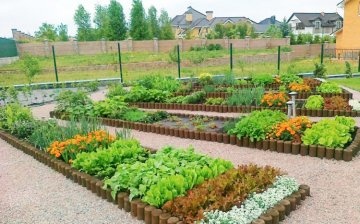
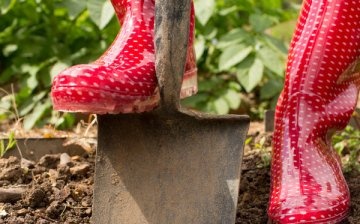
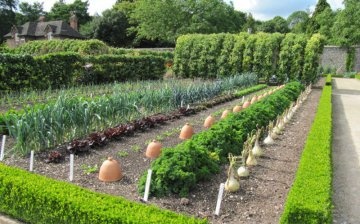

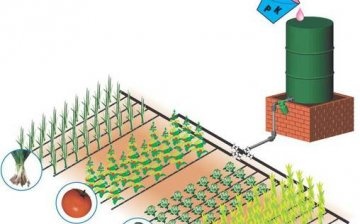





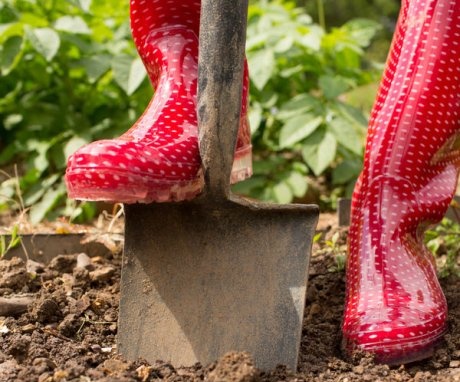



On my site, a crop rotation can only work out between cucumbers and tomatoes, since many fruit trees are planted there, and they shade vegetables. Therefore, it is impossible to change the place of planting of beets and carrots, since beets can grow in partial shade, but carrots cannot.
I love experimenting with combo landings. This year, it turned out successfully between the rows of onions (to make them wider) to plant seedlings of stalked celery. The onions were harvested in July, and the celery is now growing there. Nobody disturbed anyone.
Usually, people have much smaller distances between plants than here we see in the photo, so not everyone can afford it, since you need a lot of land, which not everyone has.